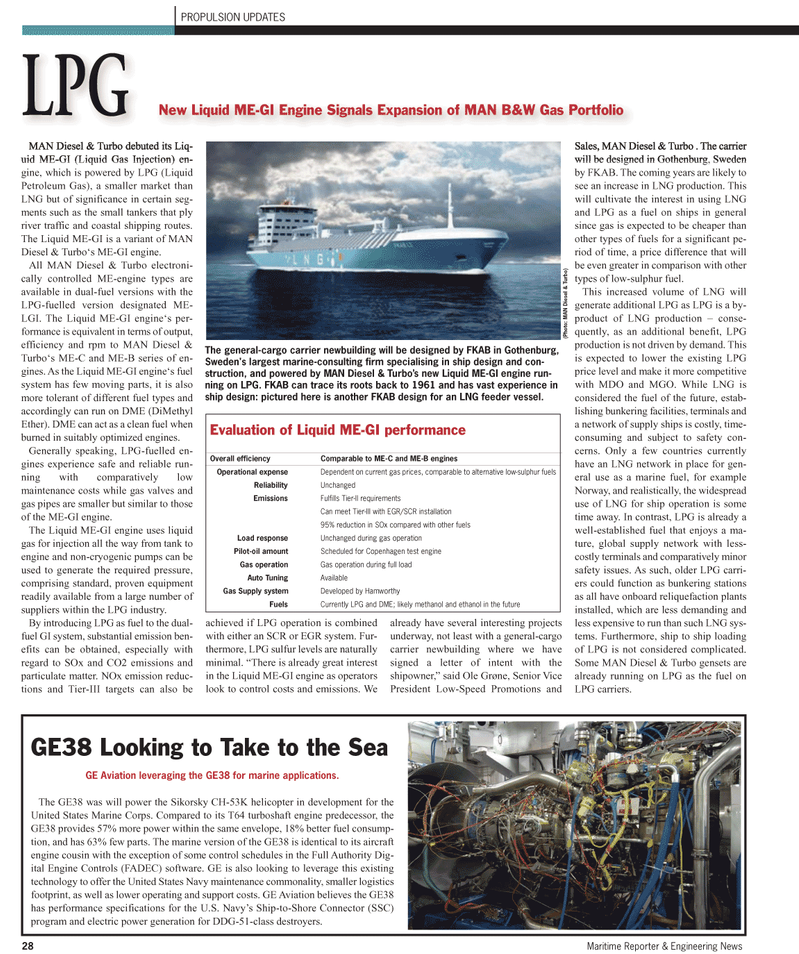
Page 28: of Maritime Reporter Magazine (February 2011)
Cruise & Passenger Vessel Annual
Read this page in Pdf, Flash or Html5 edition of February 2011 Maritime Reporter Magazine
MAN Diesel & Turbo debuted its Liq- uid ME-GI (Liquid Gas Injection) en- gine, which is powered by LPG (Liquid
Petroleum Gas), a smaller market than
LNG but of significance in certain seg- ments such as the small tankers that ply river traffic and coastal shipping routes.
The Liquid ME-GI is a variant of MAN
Diesel & Turbo‘s ME-GI engine.
All MAN Diesel & Turbo electroni- cally controlled ME-engine types are available in dual-fuel versions with the
LPG-fuelled version designated ME-
LGI. The Liquid ME-GI engine‘s per- formance is equivalent in terms of output, efficiency and rpm to MAN Diesel &
Turbo‘s ME-C and ME-B series of en- gines. As the Liquid ME-GI engine‘s fuel system has few moving parts, it is also more tolerant of different fuel types and accordingly can run on DME (DiMethyl
Ether). DME can act as a clean fuel when burned in suitably optimized engines.
Generally speaking, LPG-fuelled en- gines experience safe and reliable run- ning with comparatively low maintenance costs while gas valves and gas pipes are smaller but similar to those of the ME-GI engine.
The Liquid ME-GI engine uses liquid gas for injection all the way from tank to engine and non-cryogenic pumps can be used to generate the required pressure, comprising standard, proven equipment readily available from a large number of suppliers within the LPG industry.
By introducing LPG as fuel to the dual- fuel GI system, substantial emission ben- efits can be obtained, especially with regard to SOx and CO2 emissions and particulate matter. NOx emission reduc- tions and Tier-III targets can also be achieved if LPG operation is combined with either an SCR or EGR system. Fur- thermore, LPG sulfur levels are naturally minimal. “There is already great interest in the Liquid ME-GI engine as operators look to control costs and emissions. We already have several interesting projects underway, not least with a general-cargo carrier newbuilding where we have signed a letter of intent with the shipowner,” said Ole Grøne, Senior Vice
President Low-Speed Promotions and
Sales, MAN Diesel & Turbo . The carrier will be designed in Gothenburg, Sweden by FKAB. The coming years are likely to see an increase in LNG production. This will cultivate the interest in using LNG and LPG as a fuel on ships in general since gas is expected to be cheaper than other types of fuels for a significant pe- riod of time, a price difference that will be even greater in comparison with other types of low-sulphur fuel.
This increased volume of LNG will generate additional LPG as LPG is a by- product of LNG production – conse- quently, as an additional benefit, LPG production is not driven by demand. This is expected to lower the existing LPG price level and make it more competitive with MDO and MGO. While LNG is considered the fuel of the future, estab- lishing bunkering facilities, terminals and a network of supply ships is costly, time- consuming and subject to safety con- cerns. Only a few countries currently have an LNG network in place for gen- eral use as a marine fuel, for example
Norway, and realistically, the widespread use of LNG for ship operation is some time away. In contrast, LPG is already a well-established fuel that enjoys a ma- ture, global supply network with less- costly terminals and comparatively minor safety issues. As such, older LPG carri- ers could function as bunkering stations as all have onboard reliquefaction plants installed, which are less demanding and less expensive to run than such LNG sys- tems. Furthermore, ship to ship loading of LPG is not considered complicated.
Some MAN Diesel & Turbo gensets are already running on LPG as the fuel on
LPG carriers.
PROPULSION UPDATES
LPG New Liquid ME-GI Engine Signals Expansion of MAN B&W Gas Portfolio
The general-cargo carrier newbuilding will be designed by FKAB in Gothenburg,
Sweden's largest marine-consulting firm specialising in ship design and con- struction, and powered by MAN Diesel & Turbo’s new Liquid ME-GI engine run- ning on LPG. FKAB can trace its roots back to 1961 and has vast experience in ship design: pictured here is another FKAB design for an LNG feeder vessel. (Photo: MAN Diesel & T urbo)
Evaluation of Liquid ME-GI performance
Overall efficiency Comparable to ME-C and ME-B engines
Operational expense Dependent on current gas prices, comparable to alternative low-sulphur fuels
Reliability Unchanged
Emissions Fulfills Tier-II requirements
Can meet Tier-III with EGR/SCR installation 95% reduction in SOx compared with other fuels
Load response Unchanged during gas operation
Pilot-oil amount Scheduled for Copenhagen test engine
Gas operation Gas operation during full load
Auto Tuning Available
Gas Supply system Developed by Hamworthy
Fuels Currently LPG and DME; likely methanol and ethanol in the future
GE38 Looking to Take to the Sea
GE Aviation leveraging the GE38 for marine applications.
The GE38 was will power the Sikorsky CH-53K helicopter in development for the
United States Marine Corps. Compared to its T64 turboshaft engine predecessor, the
GE38 provides 57% more power within the same envelope, 18% better fuel consump- tion, and has 63% few parts. The marine version of the GE38 is identical to its aircraft engine cousin with the exception of some control schedules in the Full Authority Dig- ital Engine Controls (FADEC) software. GE is also looking to leverage this existing technology to offer the United States Navy maintenance commonality, smaller logistics footprint, as well as lower operating and support costs. GE Aviation believes the GE38 has performance specifications for the U.S. Navy’s Ship-to-Shore Connector (SSC) program and electric power generation for DDG-51-class destroyers. 28 Maritime Reporter & Engineering News

 27
27

 29
29
